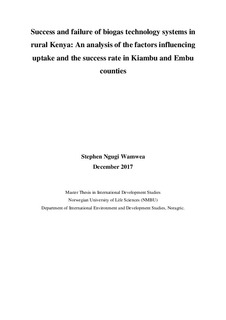| dc.description.abstract | Since biogas technology was introduced in Kenya in 1954, adoption and sustainability of the technology is still low, currently at 0.03% of the 1.2 million households with the technical potential to own biogas, especially in the rural areas. This low success rate is as a result of organizational, institutional, technical, cultural and socio-economic factors. Similarly, widespread adoption of the biogas technology has been hampered by lack of information on its benefits and the high costs of the initial designs and systems. Other constraints that hinder the adoption and sustainability of the technology by the rural farmers are lack of technical knowledge on maintenance and operation, wrong feeding regimes of the digesters and incorrect ratio of feedstock mixture. The farmers also lack capital and credit facilities, subsidy provision, and government extension services. Kenya currently suffers from the intertwined problems of climate change, food insecurity and energy poverty. Biogas technology has been regarded as a solution to these three problems. Although biogas technology has been thouroghly studied in Europe and Asia, little effort has been made to study the same in sub-Saharan Africa. Biogas technology success has continued to be problematic in spite of the partnerships with international organisations such as SNV and GTZ and being linked to poverty alleviation and development in rural areas
The purpose of this research is to investigate the success and failure of biogas systems by analysing the factors that influence the adoption, uptake, sustainability and the success rate of biogas technology in Kiambu and Embu counties of Kenya. The study sought to gather information on the physical conditions of biogas digesters, how the biogas technology functions, the feelings and perceptions of the people who have installed the technology, the impact that biogas has on users and whether the rural farmers have the necessary capacity to adopt and maintain the biogas technology. This study was futher to identify under which technical, social, economic, and cultural conditions the biogas technology can work best and ensure long-time functioning. In order to achieve these objectives, the study carried out a detailed analysis of biogas digester systems that have been installed for more than five years. Recent designs are found to perform better than the older ones. This research analysed the entire biogas system, factors affecting its productivity as well as its stability. It was also necessary to study the faults in in the biogas systems which are found in five main subsystems namely structural components, biogas utilization equipments, piping system, biogas production and effluent disposal system. The outcome of this study shall identify under which conditions biogas technology can work best and sustainably, that is, the success and failure of the systems.
The sample size was 176 respondents. Both qualitative and quantitative research methods were used in the study based on the problem analysis method in order to find out the problems associated with the failure and success of biogas technology systems. The activities of this study were divided into four phases namely desk study, data collection, data analysis and thesis writing phase. The secondary data was collected from scholary sources and are referenced in this thesis. The limitations were that the sample size of 176 respondents was too small quantitatively. In addition, sensitive personal information gathered during interviews from the respondents could not be guaranteed to be 100% trustworthy. Finally, time and finances to conduct this study thoroughly was also a limitation.
This study found that the common biogas digesters sizes were 4,6,8,10,12 m3. Cow dung was the most regular feedstock used. Most respondents did not follow the recommended measurements including the mixture ratio of dung and water of 1:1, the substrate temperature which is best between 32-40°C and the substrate pH which is best between 6.5-7.5. However, almost all respondents removed the condensed water from the gas pipeline using a water trap. Similarly, most respondents did not know why the flame colour was either yellow or blue and what that indicated. A yellow flame is an indicator that the biogas produced is not enough while a blue flame indicates the biogas produced is enough. Those who had adopted the biogas technology were not necessarily of the medium or high educational levels as has been previously found. Neither was adoption determined by the number of livestock or the size of land ownership. Slurry was used as an alternative to chemical fertilizer and also increased algae growth in fish ponds which the fish feed on, thus increasing fish production. Satisfaction from using biogas was derived from the benefits gained including time and money saved, reduced workload, improved health and quality of life. Women were the main beneficiaries within a family setup. Payback period of the biogas technology was found to be 1.7 years. The Net Present Value (NPV) was positive making the technology worth investing in. The economic benefits to the wider society from adopting the biogas technology were found to be cleaner environment, conservation of forest, increased food production, reduced carbon emissions/global warming, improved health, economic growth, poverty alleviation, increased employment opportunities, more free time for women, increased happiness due to better lifestyle and food security. A modern fibreglass biogas digester was found to be more convenient than the traditional digesters in terms of cost, strength, transportation, installation, repair and maintenance. Key actors in the biogas industry which are the government, private sector and NGOs should work together to enhance the quality and the quantity of biogas technology in Kenya. In addition, further research is necessary on the improvement on how biogas systems can work best. | nb_NO |

